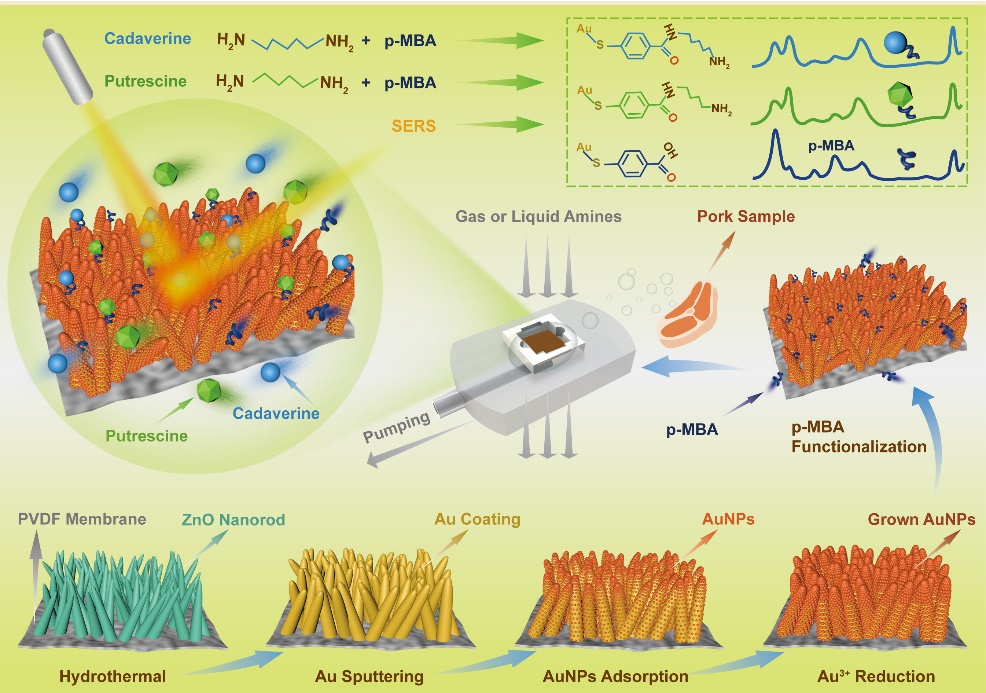Trace gas sensing is critical for monitoring environmental pollution and detecting volatile organic compounds (VOCs) released from the human body. Various analytical techniques have been explored for gas analysis, but most of them suffer from disadvantages, such as high costs, complicated sample preparation processes, sophisticated operation, and time-consuming analytical procedures. Surface-enhanced Raman spectroscopy (SERS), a powerful analytical tool for identifying trace molecules, enables remarkable amplification of normal Raman signals by using the surface plasmon resonance effect and charge-transfer effect. With excellent sensitivity, noninvasive detection capability, and unique fingerprint effect, SERS has been employed for widespread analysis applications, especially for gas sensing.
Recently, Prof. ZHANG Zhiqiang and Dr. SUN Jiaojiao from Suzhou Institute of Biomedical Engineering and Technology (SIBET) of the Chinese Academy of Sciences developed a highly sensitive three-dimensional (3D)-rosettelike SERS substrate (BigAuNP/Au/ZnO/P). The SERS substrate was made by a combination of the merit of the 3D morphology of ZnO nanorod arrays on a flexible porous poly (vinylidene fluoride) (PVDF) membrane and the in situ chemical growth of Au nanoparticle seeds on the Au film-coated ZnO nanorods, which produced a 3D-rosettelike BigAuNP/Au/ZnO/P heterostructure with abundant SERS-active "hot-spots" that significantly enhanced localized surface plasmon resonance effect and charge-transfer effect of Raman enhancement. Using the p-mercaptobenzoic acid (p-MBA) as the probe molecules with a concentration down to 10-13 M, the SERS substrate presented an enhancement factor (EF) as high as 2.27 × 107 with excellent uniformity and reproducibility (RSD < 4%). More importantly, the porous structures of the PVDF membrane can facilitate the interaction of "hot spots" with analytes and assist the selective detection of a gaseous target in a complex environmental condition.
In this work, putrescine and cadaverine were selected to confirm the practicability of the 3D flexible SERS substrate in gas sensing. With the p-MBA molecular monolayer as the sensing interface, the gaseous putrescine and cadaverine were selectively captured through amide reaction and quantitatively detected at low concentrations (putrescine: 1.26 × 10-9 M; cadaverine: 2.5 × 10-9 M). The detection limits are 2 ~ 3 orders of magnitude lower than that reported in prior literature, indicating the good gas sensing performance of this SERS substrate.
Taking advantage of the flexibility, porosity, and excellent SERS performance, this 3D flexible substrate can be integrated with a microfluidic device and a portable Raman spectrometer to build an on-site SERS detection system. Such a system is expected to enable efficient capture and enrichment of bacteria, viruses, and pollutants in aerosols for applications including food quality determination, environmental monitoring, and disease diagnosis.
The research results have been published in Analytical Chemistry, entitled "Ultrasensitive SERS analysis of liquid and gaseous putrescine and cadaverine by a 3D-rosettelike nanostructure-decorated flexible porous substrate." The first author of this paper is Dr. Sun Jiaojiao, and the co-corresponding authors are Prof. Zhang Zhiqiang, Prof. Yin Huancai, and Prof. Song Yizhi.
This work was supported by the National Natural Science Foundation of China, the Key Research and Development Program of Jiangsu Province, and the Scientific Instrument Developing Project of the Chinese Academy of Sciences.

Figure 1. The SERS sensor. (Image by SIBET)
Contact
XIAO Xintong
Suzhou Institute of Biomedical Engineering and Technology, Chinese Academy of Sciences (http://www.sibet.cas.cn/)
Phone: 86-512-69588013
E-mail: xiaoxt@sibet.ac.cn